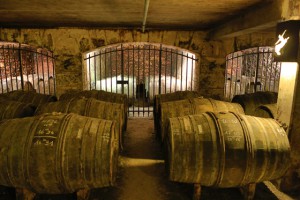
Exploring the world of Brandy
Brandy is a rather broad category. In simple terms Brandy is a Spirit made by distilling wine or any fermented fruit juice. The alcohol strengths vary and some Brandies are aged in wood while others remain as clear as they were as they left the still.
The history of Brandy surely flows along side the history of distillation. By nature Brandy and wine have evolved together. Centuries ago transporting wine and having it arrive to its destination in good condition, was often difficult. Distilling wine provided a preservation method as the volume was greatly reduced, Brandy is more hearty than wine, and when taxes were assessed simply on volume Brandy was preferred.
France offers us a trio of world famous Brandies: Cognac, Armagnac, and Calvados. Among these, Cognac is certainly king in regard to recognition and reach. We have examined each of these great Brandies in depth and their stories can be found here:
While we can’t cover every Brandy style and variation made in the world today we will take a look at some of the most popular examples.
Pisco
There is no hotter Brandy than Pisco, as sales of this unique spirit have been leaping forward since 2010. The USA is the second largest importer of Pisco behind Chile, one of the two South American nations that produce Pisco (Peru being the other).
Pisco is made entirely from grapes, most frequently single distilled, unaged, and unaltered in any way. Pisco is very fragrant, a bit raw to the uninitiated, and frequently consumed in cocktails most — notably the famous Pisco Sour.
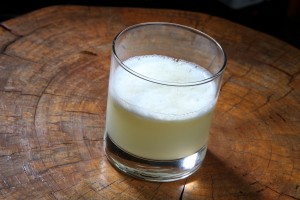
The classic Pisco Sour
To say that there is a rivalry between the two Pisco producing nations of Peru and Chile would be a great understatement. Pisco producers in even Peru strongly object to Chilean producers using the name Pisco. The Peruvians claim that the spirit takes its name from the town, valley, and river of the same name located decidedly in Peru. Others claim that the term Pisco was used in many nations all along the Pacific coast of the Americas. There is much more to the argument but suffice it to say that the spat will not be resolved anytime soon.
Pisco (both Chilean and Peruvian), like Cognac, is distilled from wine made from a variety of permitted grapes. In Peru, Pisco can be made in one of five D.O. (Denomination of Origin) located along the Pacific coast. In Chile, Pisco must be made in one of the nation’s two permitted zones.
Peruvian Piscos made from a single grape may be called “Puro.” Peruvian Pisco made from two or more grapes is labeled as “Acholados.” “Mosto Verdes” are Pisco distilled from wine that has not fully completed fermentation and is thus sweet.
In Chile, Pisco is designated by four classifications dependent upon alcohol strength or proof. Chilean producers are required to grow their own grapes and are grouped into two primary classes based on aromatics with Muscat being the preferred grape.
Peruvian Pisco must be distilled just once in a copper pot still and distilled to proof meaning that no water may be added. The best Chilean Pisco is also single distilled while a double distillation is permitted.
While oak aging is a key component to many of the world’s greatest Brandies, Pisco is by rule oak-free but does rest in tanks for a minimum of three months in Peru.
A final point of difference is that Peru makes three to four times as much Pisco as Chile while Chileans drink nearly six times the Pisco as Peruvians and are Peru’s number one export market.
Brandy de Jerez
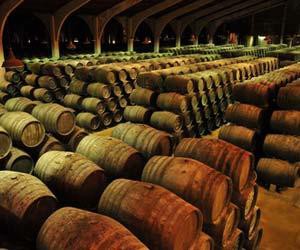
Beautiful Brandy de Jerez
Brandy de Jerez, like Cognac, is made from a distillation of wine. It just so happens that Brandy de Jerez is made in Jerez (of course), which is world famous from its production of Sherry. Of course there is a very close and symbiotic connection with Sherry.
Brandy de Jerez is made exclusively with the Airén grape variety, also known as Palomino. The finished wines are then distilled in either column or copper pot stills depending upon the individual producer’s preference.
Brandy de Jerez is aged in American oak casks that have previously held one of Sherry’s great styles: Fino, Amontillado, Oloroso, and Pedro Ximénez. These 500-600 liter casks are the renowned Sherry butts that are utilized to age other great spirits like Scotch and Irish Whiskies. The Sherry butts are arranged in the famed solera aging system. (Learn about Solera here.)
Once aged, there are three classifications of aged Brandy de Jerez: Solera – aged a minimum average of six months, Solera Reserva – aged a minimum average of one year, and Solera Gran Reserva – aged a minimum average of three years. Most of the Brandy de Jerez seen in the export market is of the Solera Gran Reserva class.
Brandy de Jerez is a deep amber color in the glass with scents and flavors of roasted nuts, dried fruits, molasses, and oak. It can be enjoyed neat or in cocktails.
California Brandy
Americans often wonder why there are so many large, established Brandy producers in central California. Brandy production was introduced to California via Spanish Catholic missions that made their way through the territory traveling south to north. They found that the land and climate was ideal for the planting of grapes so naturally winemaking and distilling followed.
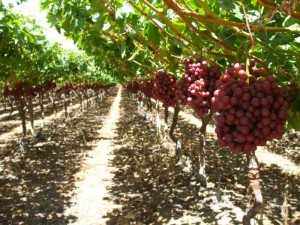
Historic California Brandy
By 1823 there were 21 Franciscan Missions in California and all but four had vineyards for wine and Brandy production. By the beginning of America’s Civil War many more had come from America’s East Coast, as well as Europe to make wine and Brandy in California.
By the 1870s many of Europe’s vineyards were devastated by phylloxera. Brandy production in France, Spain, and Germany all but collapsed. At the same time California’s Brandies had earned a great reputation on the East Coast and beyond to Europe. California-made Brandy was on the rise until… Prohibition.
Prohibition devastated the California Brandy industry. New laws, regulations, and taxes that came after repeal made sure that the California Brandy business would look very different from it had pre-Prohibition.
California law that mandated via the grape-prorate law that every producer of grapes must distill 45% of their crops to be aged for two years. Odd indeed but this does explain why California is the home of US Brandy production. A sensible law was enacted in 1941 placing a ceiling of 85% alcohol-by-volume on Brandy distillation to assure that California Brandy would have guts and not be a neutral spirit. By the 1960s Brandy consumption was up 400% since repeal and 75% of the Brandy was coming out of California.
Today, California Brandy is made from wine made from a large variety of grapes. It’s often sold at bargain prices and even XO-level Brandies from some of California’s biggest, oldest, and most famous producers are outrageously affordable.
Grappa
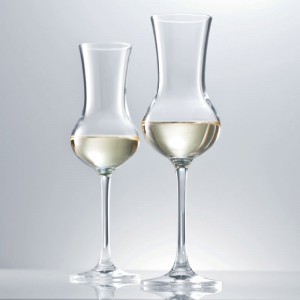
Pure Grappa
Grappa is Italy’s very fragrant Spirit whose base material is the crushed grapes or pomace (known as Vinaccia in Italian) left over from the production of wine. Grappa is not unique in the spirit world having similarly made Spirits produced in France known as Marc, Spain has Aguardiente, and in Portugal it is called Bagaceira. Until recent years, primarily the late 1980s, Grappa was made with little care and was viewed as a drink for the poor and usually added to espresso or drunk with fruit syrups.
Before the 1980s Grappa was scarcely known outside of Italy. Seemingly overnight trattorias and ristorantes in London, New York, and Chicago were offering Grappa. Stranger still these Italian-influenced restaurants offered a collection of Grappa in ornate, hand-blown glass bottles, and prices-per-shot rivaling what the diner had just paid for his Bistecca Fiorentina. Nothing energizes the hipsters like charging loads of cash for something unknown by many of their contemporaries. In a flash Grappa went from peasant to chic.
Three decades past Grappa’s fad-like introduction, the mysterious Spirit has been largely forgotten save a steadfast group of supporters. Grappa production, on the other hand, has become even more fastidious and the number of labels available and their prevailing quality is greater than ever. The time for a Grappa revival has never been better as the ornate packaging has greatly disappeared and now consumers are asked to simply to pay for the wonderful Spirit within.
Eaux-de-vie
Eaux-de-vie (EDV), or aqua vitae. However you say it, or whatever language you choose, it comes out the same; “water of life.”
As a spirits category EDV is much neglected particularly in America were it is most often relegated to culinary tasks. This is very sad indeed. In a large sense EDV can be defined as a distillate of any fruit. Before they are aged in wood casks, the world’s most famous Brandies, Cognac, Armagnac, and Calvados are crystal clear and could be classified as EDV. A small handful of producers in these regions do bottle clear, unaged spirits to showcase the purity of fruit found in their aged products albeit masked by wood and the effects of maturation.
Eaux-de-vie is most commonly made from fruits other than grapes. The most common fruits used to produce are: Poire-Williams (pear), Framboise (raspberry), Kirsch (cherry), Mure (blackberry), and Fraise (strawberry). Many consumers see the fruit names on the bottles and mistakenly believe that these spirits are sweet; EDV is NOT sweet and is in fact quite dry.
Good EDV doesn’t come cheap, nor should it. A bottle of Vodka can be made for much less than a buck’s worth of raw ingredients. EDV, on the other hand, packs 20 to 30 pounds of fruit in to each 750ml bottle. The distillate emphasizes purity without the luxury of wood, sugar, and other flavors that can conceal distillation flaws.
France and Switzerland are perhaps the best known producers of quality Eaux-de-vie. Some very good examples are now being made in the US and one of my personal favorites is made at a little distillery in Belgium called Distillerie de Biercee.
EDV is best served chilled and is a great accompaniment to fruit and/or cream deserts. Custard-based tarts studded with fresh fruit are an extremely good match. Avoid adding mixers with the exception of seltzer, as mixers will mask the subtle flavors. At that point you may as well be using Vodka.
